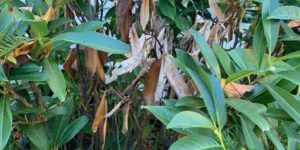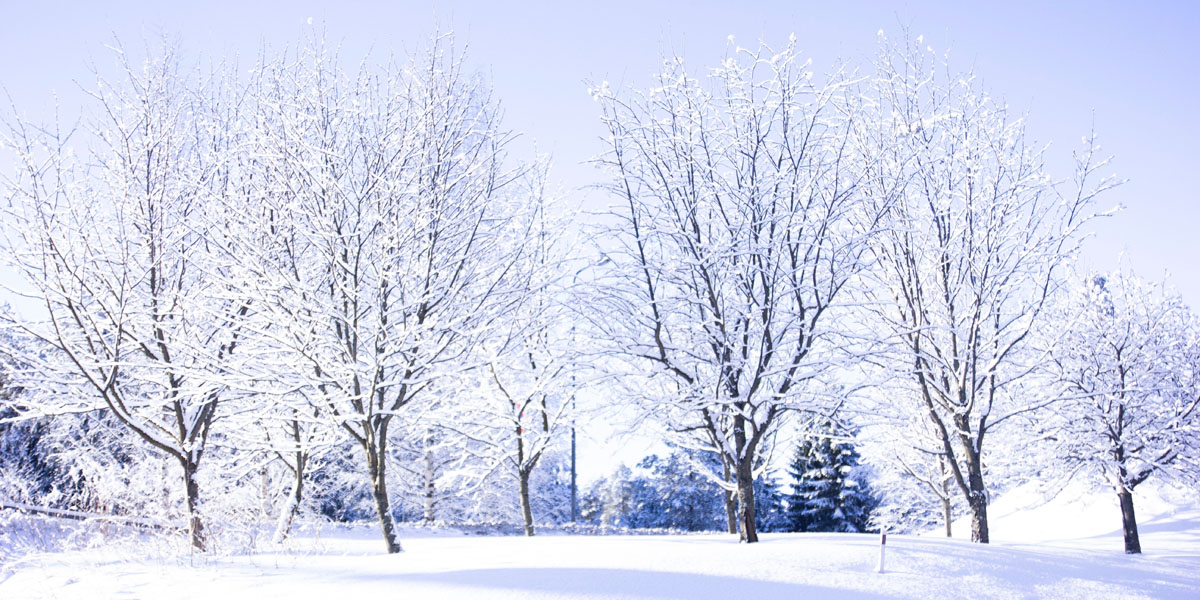Salt is really good at keeping roads and sidewalks clear of winter snow and ice, but it brings with it some side effects. The most visible side effect is damage (and even death) to both deciduous and evergreen trees and shrubs.
Salt damage usually appears in late winter and early spring, as plants emerge from dormancy. It can also show up later in summer when plants are growing most vigorously and taking up greater amounts of water and nutrients from the soil.
But now – winter – is the best time to prevent salt damage from happening.
In this article, we cover:
- how to identify salt-related injury to plants,
- why it happens,
- how to prevent salt damage to your landscape plants, and
- what to do if your trees and shrubs have been affected by winter salt or de-icers.
Identifying Salt Damage
Symptoms of injury to trees and plants begin to show up after snow has melted; generally in late winter, early spring, or summer. Look for browning needles, brown or dying leaves, or other signs commonly associated with water stress. Some signs will show up right away, other signs might take years to appear.
One of the most common places to note salt damage is on trees that border roadsides. Sometimes, entire sides of trees can turn brown from the spray caused by vehicles passing by on salt-covered roads.
However, plants and trees can also suffer from salt or ice melt applied to driveways and sidewalks, or any roadways nearby where snow piles might accumulate. As the snow melts, the melting water, as well as the ice melt product, seeps into the ground, meaning that the only water available to the plant roots is filled with salt or ice melt product.
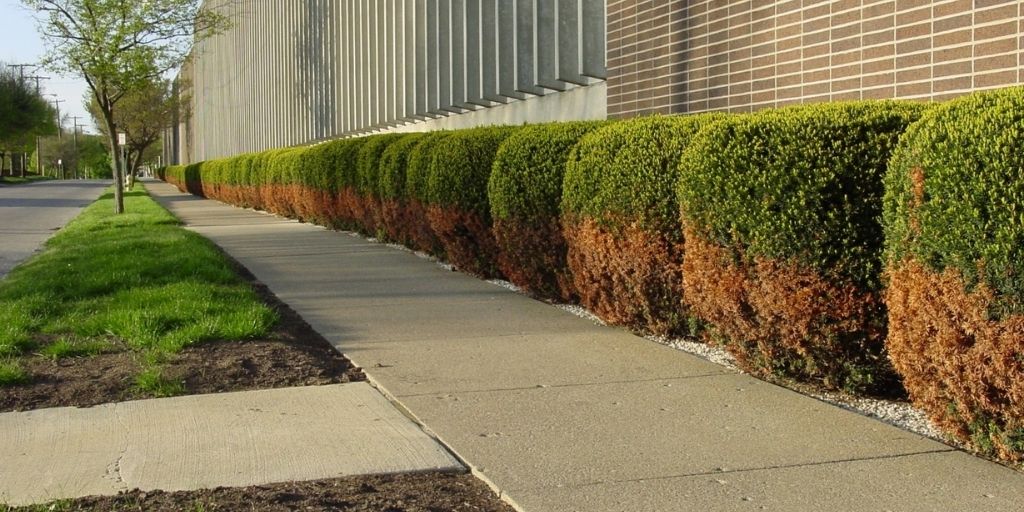
These yews suffered extensive salt damage from snow piled up against them in winter
How trees and shrubs suffer from salt
When the water underground is contaminated with salt, it’s not good for any plant. Think of it this way: what if the only drinking water available to you was salt water? Not a pleasant option, is it? But the roots of plants don’t have a choice, they will soak up any moisture that’s available to them.
Water contaminated with salt is harder for plant roots to absorb. As a result, they’re able to take up less water, causing a sort of “drought” in the area. This is why many of the symptoms of salt damage are the same as you would see during periods of drought.
The saltwater that is able to be absorbed then makes its way through the vascular system of the plant or tree. It’s eventually brought to the needles or leaves where the water is released into the air through a process called transpiration. The salt is left behind, where it builds up in the leaf or needle and begins to kill the tissue. This is when the damage begins to be noticeable, as the tips of leaves or needles turn brown as they die.
A similar thing happens when road salt is sprayed on trees by passing traffic. Instead of moving through a tree’s vascular system, however, the salt is distributed directly on the needles or leaves. As a result, large sections of foliage are killed, which is why you may spot an entire section of a tree turning brown.
The buildup of salt and the lack of usable water can eventually lead to the death of the tree or plant.
>> Read more about the damage that road salt causes to plants in New Jersey
Preventing salt damage to plants
The good news is that salt injury is preventable, if you take the right steps.
1. Be strategic with your snow piles
Piles of snow from driveways are often contaminated with salt, or some form of ice melt. If they end up over shrubs or near tree roots, those plants are most likely to suffer salt damage. Consider alternative options for where you place snow piles in your yard so that they don’t cover plants.
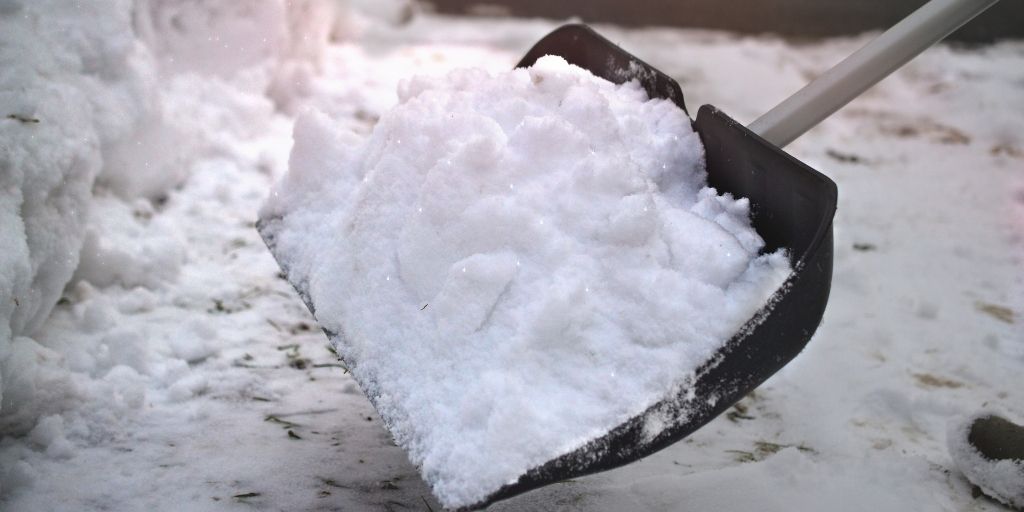
Be careful where you place snow when shoveling – keep it away from plants to avoid salt damage when the snow melts in spring.
2. Water the ground
The easiest and simplest solution to preventing winter salt damage is watering. Wait until the ground has thawed, and then water the area around your plants or trees where snow piles have melted. This leaches the salt out of the soil and makes clean water readily available for your plants to absorb through their roots.
To ensure that you reach the root zone, water slowly and for a long period of time. A short blast of water won’t reach the depth of soil where it is needed. You also don’t want to wash away any of the soil around your plants, so a garden hose with a slow release of water will provide the needed water without washing away the soil and causing erosion.
3. Water the leaves/needles
While watering the foliage of your plants won’t provide hydration, it does serve as a way to rinse any salts or ice melts off the surface. This is especially useful in areas where road spray may be an issue. Wait until temperatures are warm enough that the water won’t freeze into ice on your trees.
4. Protect plants from salt spray by wrapping them
Using a protecting wrapping such as burlap can prevent salt spray from reaching your trees, shrubs, or landscape plants. Plants should be wrapped in late fall and unwrapped in spring so as not to impede growth. Remember to continue to irrigate the trees or plants that you wrap, as some salt may still reach them through the ground.
5. Consider anti-desiccant spray
As part of our Tree Health Management program, we offer an anti-desiccant spray in the fall. This spray prevents broadleaf evergreens from drying out over the winter months, and the coating can provide some protection from salt spray as well.
Contact us to schedule your anti-desiccant spray for next fall.
6. Use a less corrosive version of ice melt
Consider switching to gravel, kitty litter, or sand to use on icy driveways. These products provide friction without actually melting the ice. Most ice melt products are made from sodium chloride or calcium chloride, which are incredibly harmful to plants. If you still want a product that melts the ice but is less harmful, calcium magnesium acetate may be an alternative option. Road salts can also cause damage to animals, especially if they lick their paws, so look for an animal-friendly option if you have pets.
Finally, if none of those options work, try using less of the ice melt but mixing it with sand or gravel. You’ll find that a little can go a long way in that instance. Make sure to clear the snow away first, and then apply the ice melt and grit to the remaining ice.
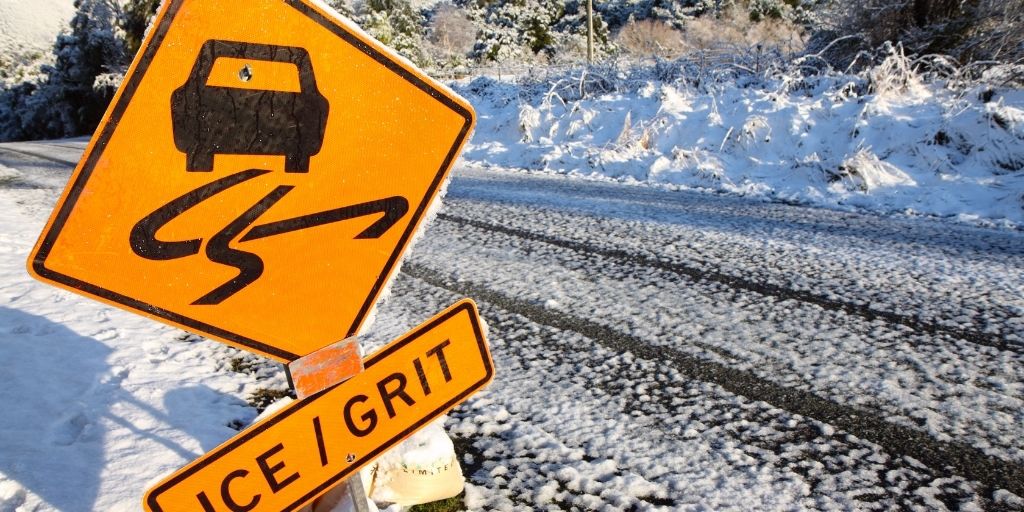
Look for alternatives to rock salt and similar ice melt products. Combining a small about with grit can cut down on winter salt damage to nearby plants.
7. Use salt-tolerant plants in your landscaping
If none of the above options works for your situation, you may want to consider planting shrubs and trees that are more tolerant of salt, especially in areas where melting snow filled with salt is unavoidable.
>> Check out this list of salt-resistant perennial plants for New Jersey from Rutgers University
Helping trees and plants recover from salt damage
If you notice any trees that are not growing well, have stunted leaves, scorched-looking leaves, browning needles, or dying branches, they may be suffering from too much salt. Make sure that they are receiving enough water and contact us to schedule a consultation. But don’t wait too long; if your plants or trees are too badly damaged, they may need to be removed.


